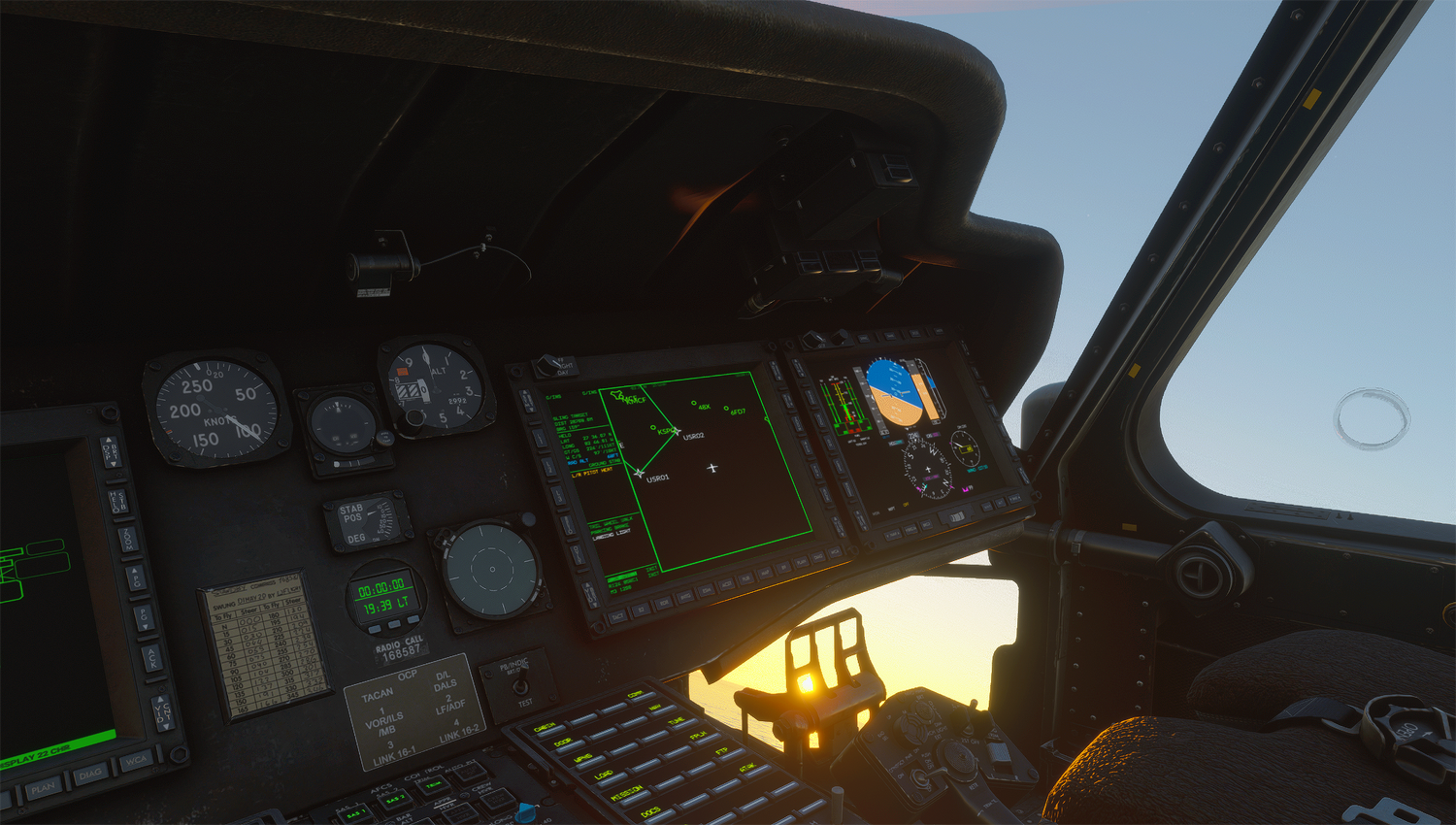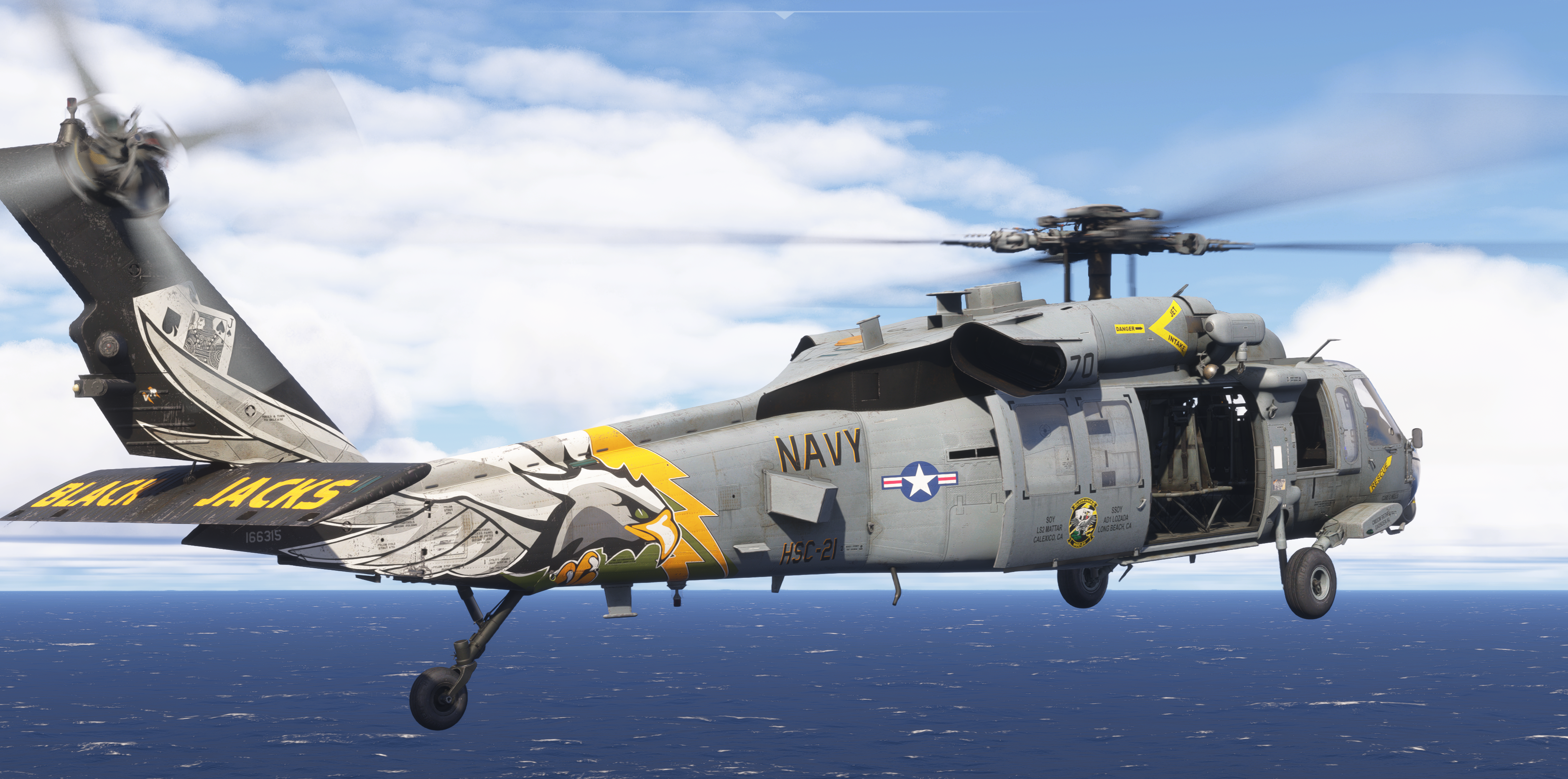Hello everyone, and welcome to our second MH60 Dev Blog!
I’d like to first apologize about the slight delay posting this Dev Blog – it was first promised for Friday, but due to various unexpected circumstances is being posted today (Sunday).
Likewise, I’d like to thank you all for reading these Dev Blogs – the first one exceeded our expectations with regards of engagement. We plan to continue sharing updates on a regular basis, approximately every two weeks. That said, please keep in mind that each post takes a significant amount of time to put together—time that could otherwise be spent developing the aircraft—so we appreciate your patience and understanding.
Avionics Suite
We're modeling the avionics suite based on the U.S. Navy's Block I MH-60S manuals, as these are currently the only publicly available references. This suite is used across all variants and features a common cockpit layout. It primarily consists of two Flight Displays (FDs), two Mission Displays (MDs), and two Keysets.
-
FLIGHT DISPLAYS (FD): The FD is the primary source of flight data and situational awareness for the crew. Engine information, ADI, altimeters, airspeed, HSI and hover parameters are all displayed on the FD.
Key parameters like barometric pressure (BARO), heading (HDG), decision height (DH), and course (CRS) can be entered directly via the bezel buttons and the Universal Control Knob located on the top bezel.
-
MISSION DISPLAYS (MD): The MD provides all mission-related information, including navigation aids, routing, maps, FLIR imagery, aircraft warnings, cautions, advisories, and system diagnostics. Due to the MD being largely undocumented and classified, our rendition is based on extrapolating the available public documentation and adapting it within the MSFS environment.
The MD—particularly the FLIR and map systems—remains the most actively developed area, with new details and improvements being added during Alpha and entering into Beta. Due to various technical limitations in MSFS, fully accurate FLIR implementation isn’t currently possible. However, we’re making significant progress beyond the typical "synthetic view" to achieve a more realistic and immersive look.

Please be aware that these screenshots feature unfinished maps and FLIR, as well as various bugs - these are being significantly improved. Fonts and Font Sizes, and Colors are subject to change during the final review phase.
- KEYSET: The keyset is a central interface designed to streamline pilot and crew interaction with the aircraft's digital systems. The Keyset allows for rapid data entry, system control (COMM, NAV, Weapons, ATAK, etc.), and navigation through menus across the flight and mission displays. We've designed the aircraft around the Keyset as the central hub for configuring the aircraft. Cabin Layouts (eg. SAR/ASW/Transport cabins), Weapon Loadouts (Hellfires/Torpedos), external tank configurations (R and T), and external loadout options (Pallets, Flags and Buckets) are all managed through the Keyset.

While Sierra and Romeo do share the exact same cockpit, in reality USCG Tangos use a different avionics suite - Common Avionics Architecture System (CAAS). This system will NOT be available on our rendition of the Tango due to project constraints and feasibility of a product of these characteristics.
Navigation Systems
Navigation on these sorts of naval helicopters is typically coordinate-based and relies on ground workstations (Mission Planning System (MPS)) to enable the crew to plan the task functions required for a flight (e.g., ferry flight, cross country, VERTREP, etc). Standard IFR procedures (SIDs/STARS) are not typically used for these sort of missions given the nature of naval aircraft.
This will be simulated in a number of different ways:
-
Web-based coordinate Flight Planner ("Miltech INS Planner"): Initially developed for M2KC, our coordinate-based planner system is being expanded and improved to support a larger number of waypoints, and over-the-network flightplan synchronization directly to the aircraft. This is supposed to simulate how naval pilots load flightplans using data cartridges. Various UI changes and improvements are also being made to fit more the aesthetic of real MPS, which interestingly enough still run in Windows 2000. Pictured below is the current UI of INS Planner, prior to UI changes. While INS Planner doesn’t yet support SIDs, STARs, or IFR routing, we’re exploring the addition of VORs, fixes, and other relevant navigation data to enhance its functionality.

- WorldMap/EFB Tablet Sync: The FS24 Tablet has evolved into a very good flight planning tool, and naturally, the aircraft will feature seamless integration with it.
- Fly-to-point (FTP) Waypoint: Coordinate-based FTPs can also be entered manually through the Keyset.
- Search Patterns: Expanding Square, Sector Search and Parallel Sweep search patters are easily programmable through the keyset. Entering a search pattern will overwrite the current flight plan. A "Direct Return to Base" function is also supported through the search pattern submenu.
- VOR, ILS, TACAN, ADF, etc.
- We are looking into Siembrief Integration as well, however, it will likely come in as a future update (not on initial release) given the use of external APIs.
Autopilot
A fully functional 6-degree-of-freedom Autopilot (AFCS) and Stability Augmentation System (SAS) has been developed specifically for this aircraft.
The CH47 input-based system had two major flaws: being input-based, it was subject to conflict from input from physical hardware, and therefore required significant deazones; and was subject to error accumulation, resulting in undercorrection of altitude/heading over time.
The new system utilizes rotor trim and acceleration control systems to modify the dynamics of the aircraft without conflicting with user input (except collective). The result is a responsive autopilot system, with smooth and dynamic flying experience, with realistic hover attitudes and acceleration/deceleration regimes.
All AFCS Modes are modeled as per the aircraft manuals:
- AUTO PLT: Maintains aircraft attitude below 50 knots or airspeed above 50 knots, with heading hold functionality.
- RAD ALT / BARO ALT: Holds the aircraft’s altitude at the moment of engagement, based on radar or barometric altitude.
- APPR / HOVER: Transitions the aircraft from cruise to a stable hover in minimal time. Hover altitude and lateral/longitudinal speeds are fully adjustable via cockpit knobs.
- CREW HOVER: Allows keybind control over lateral and longitudinal speeds for precise maneuvering during SAR operations.
-
DEPART: Initiates a climb from hover to a safe altitude and accelerates to 120 knots as quickly as possible.
Please note that this aircraft does NOT have any "LNAV" modes - it cannot follow a flightplan entered on the navigation systems.
Stability Augmentation is also fully modeled—disabling the SAS will noticeably impact aircraft handling and significantly increase pilot workload.
Force Trim, though planned, will not be available on initial release. This is mainly due to concerns with compatibility with various types of hardware. There is, however, a good freeware addon to simulate Force Trim.
Mission Systems
We’ll be sharing more details and insights about the mission system in the next Dev Blog. In the meantime, here’s a sneak peek: a VERTREP mission taking place at Peñón de Vélez de la Gomera, one of the included mini-scenery locations.
The mission system we're building is fully modular and can be easily adapted to other devs' aircraft. In fact, it’s already being explored for use by a well-known developer - more on that soon.

... but when
As we move into the "Early Beta" phase, we’d like to clarify a few important points:
- The aircraft will remain fully closed and internal. We are not looking for beta testers. We receive dozens of requests every week and already have more than enough testers involved.
- There will be no official release date announced until we are 100% confident we can meet it. This means the release date will only be shared a few days in advance. The aircraft will be released when it's ready—please refrain from asking or complaining about "delays." We are committed to delivering a fully polished product and will not release anything half-baked
-
We cannot yet confirm a same-day release for both PC and Xbox. While that is the goal, and we are starting the process as early as possible, there are factors outside of our control. Rest assured, we’ll do everything we can to minimize the gap between both platforms.
Non MH-60 Topics
We’re also taking this opportunity to share a few updates on projects beyond the MH60, especially now that these Dev Blogs are gaining popularity!
- Amphibious Ready Group, FS24: An update is set to release in a few days, mainly addressing FS24 compatibility issues, and graphical improvements to the ships.
-
M2KC, FS20 and FS24: Version 1.1.0 is currently in the works. No ETA.
- FBW will now be automatically disabled upon gear extension, to avoid pitch sensitivity issues
- Audio on multiplayer is being reviewed
- Various cosmetic changes
- Over-the-cloud flightplan synchronization with Miltech INS Planner, expanding waypoint limits.
- And a few surprises.. 😉
- MV-22 for FS24: We're currently working on an update to enable EFB flight plan synchronization with the avionics. It's nearly complete, but unfortunately, we've run into some issues with the SU2 Beta.
- C-17: Future update announcements to come from Microsoft.
- CH47D for FS24: A few minor bugs are logged, but prioritized low due to high workload.
-
Supercarrier Pro for FS24: Only bug logged is related to violent oscillation of ships due to new water physics. We are awaiting for Asobo to address this problem.




Leave a comment
This site is protected by hCaptcha and the hCaptcha Privacy Policy and Terms of Service apply.